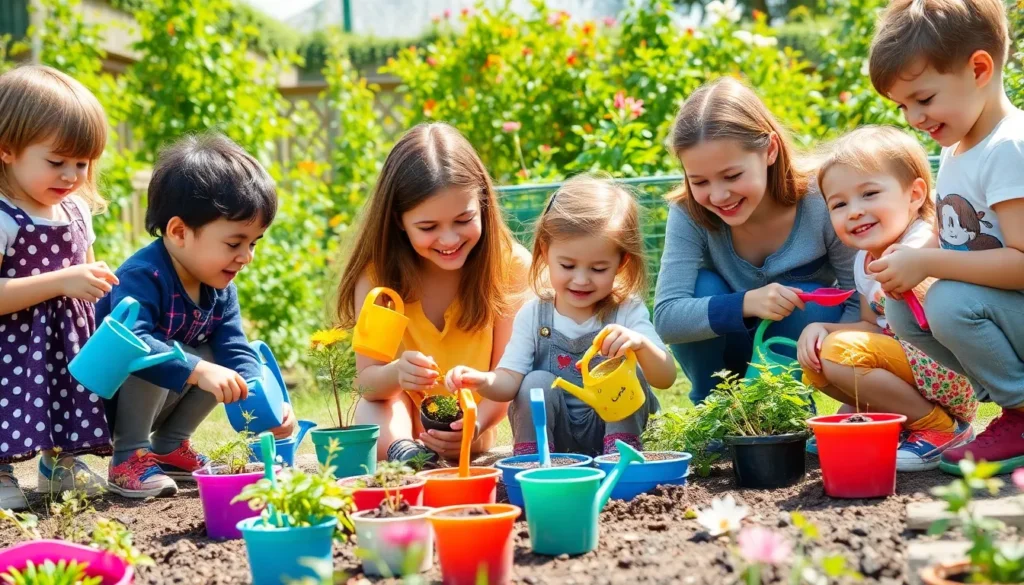Watching little hands dig in the dirt and eyes light up when tiny seeds sprout into green shoots creates magical learning moments we’ll never forget. Teaching preschoolers about plants and gardening opens up a industry of discovery that combines science education with hands-on exploration in ways that captivate young minds.
We know how challenging it can be to find captivating activities that keep preschoolers focused while teaching valuable lessons. That’s why plant-based learning activities work so beautifully – they naturally combine sensory experiences kids crave with foundational concepts they need to learn.
Our comprehensive guide transforms your classroom or home into a thriving garden laboratory where children develop fine motor skills through planting seeds and strengthen observation abilities by tracking plant growth. You’ll discover how simple gardening activities teach responsibility while introducing essential science concepts like life cycles and plant parts.
Create a Classroom Garden Center for Hands-On Learning
Building a dedicated garden center transforms your classroom into an interactive botanical workspace where preschoolers can explore plant life through tactile experiences. We’ll show you how to organize essential stations that encourage independent exploration while developing crucial skills.
Set Up Planting Stations With Child-Sized Tools
Organize low tables or trays at preschooler height to create accessible planting workspaces. We recommend using 12-inch high surfaces with non-slip mats underneath plastic containers or shallow trays. Small hand trowels, measuring 4-6 inches long, fit perfectly in tiny hands while allowing proper grip development.
Include child-safe watering containers like squeeze bottles or small watering cans with 8-ounce capacity. These tools help preschoolers control water flow without overwhelming their seedlings. Add measuring cups in ¼ cup and ½ cup sizes for soil portioning activities.
Stock each station with potting soil in easy-pour containers and seed starting trays with large cells. We suggest 2-inch diameter cells that accommodate small hands during planting activities. Place paper towels and wet wipes nearby for quick cleanup after hands-on exploration.
Display Seed Packets and Garden Catalogs
Mount seed packets at child eye level using clear plastic sleeves or poster boards with pockets. We arrange packets by plant categories like flowers, vegetables, and herbs to encourage classification skills. Choose packets with colorful photographs that show both seeds and mature plants.
Create a reading corner with garden catalogs and picture books about plants. We place these materials in a basket or low bookshelf where children can browse independently. Include catalogs from companies like Burpee or Ferry-Morse that feature large, vibrant plant photographs.
Add magnifying glasses near the seed display so preschoolers can examine actual seeds up close. We provide 3x magnification tools that are sturdy enough for classroom use. This setup encourages observation skills and vocabulary development as children describe seed shapes, sizes, and textures.
Include Measuring Tools for Growth Charts
Provide child-friendly rulers marked in both inches and centimeters for daily plant measurements. We recommend 12-inch rulers with large, clear numbers that preschoolers can read easily. Flexible measuring tapes work well for measuring around plant stems or larger specimens.
Set up growth chart templates where children can record their observations daily. We create simple charts with picture symbols and number lines that accommodate different developmental levels. Include colored pencils or markers for recording measurements and drawing plant changes.
Install a height measurement station using a yardstick mounted vertically on the wall. We mark this tool with colorful tape at 1-inch intervals to help children identify measurement points. This visual reference helps preschoolers understand concepts like “taller than” and “shorter than” while tracking their plants’ progress.
Design Plant Life Cycle Activities That Engage Young Minds
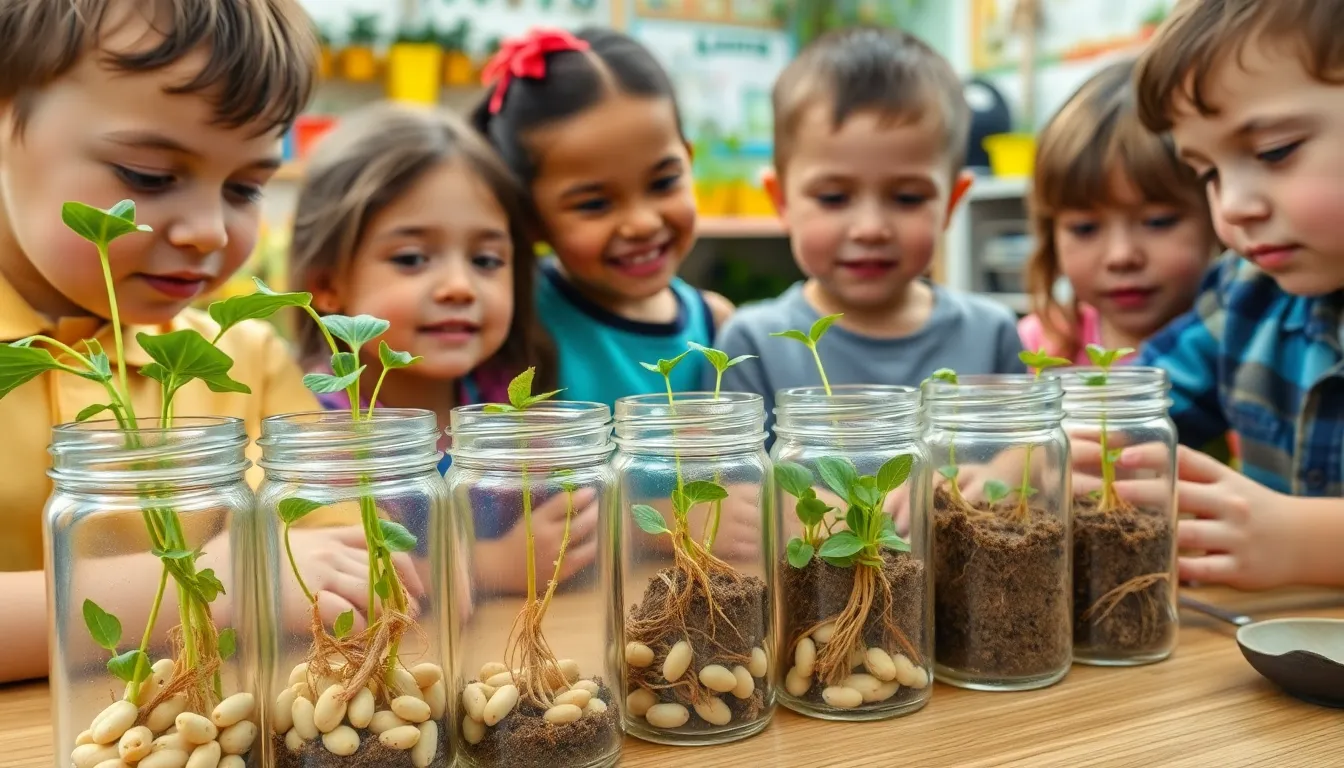
Building on your established garden laboratory, we’ll now explore exact activities that transform abstract botanical concepts into concrete learning experiences. These captivating approaches help preschoolers grasp the sequential nature of plant development through multiple sensory channels.
Use Bean Seeds for Observable Growth Experiments
Bean seeds offer preschoolers the perfect window into plant development because they germinate quickly and showcase visible changes within days. We recommend starting with the clear jar method, where children place bean seeds between wet paper towels and the glass walls of a mason jar to watch roots and sprouts emerge in real time.
Another effective approach involves creating “sprout houses” by positioning seeds on moist paper towels near sunny windows, demonstrating how plants require water, sunlight, and air without the distraction of soil. This method emphasizes the three essential growth requirements while providing unobstructed views of the germination process.
These experiments naturally encourage prediction skills as children guess what changes they’ll observe next, followed by careful observation and recording of actual results. Teachers report that this hands-on approach maintains engagement levels significantly higher than traditional picture-based lessons alone.
Create Life Cycle Wheels and Flip Books
Life cycle wheels transform the abstract concept of plant growth into an interactive tool that preschoolers can manipulate independently. We construct these by drawing or attaching images of seed, germination, seedling, and mature plant stages on rotating cardboard wheels that children spin to visualize the complete growth progression.
Flip books provide another tactile learning method where children turn pages to reveal each developmental phase in sequence. This format reinforces sequential thinking while developing fine motor skills through page-turning actions and supports vocabulary building as children name each stage they encounter.
Both tools make complex biological processes accessible to young learners by breaking them into manageable visual segments. Children often request repeated use of these materials, indicating their effectiveness at maintaining interest while reinforcing plant life cycle concepts.
Carry out Daily Growth Observation Journals
Daily observation journals establish routine scientific thinking patterns while documenting actual plant changes over extended periods. We provide simple charts or booklets where children draw pictures, add stickers, or write basic words to record what they notice about their seeds, sprouts, and developing plants each day.
This documentation process develops attention to detail as children compare today’s observations with yesterday’s entries, fostering analytical thinking skills essential for scientific literacy. Teachers guide discussions about plant needs during journal time, connecting observations to care requirements like watering schedules and sunlight exposure.
The journaling approach creates lasting records of learning that children can review weeks later, reinforcing memory retention while building pride in their scientific documentation abilities. Many classrooms display these journals as evidence of individual growth alongside their plants’ development.
Incorporate Science Experiments With Seeds and Plants
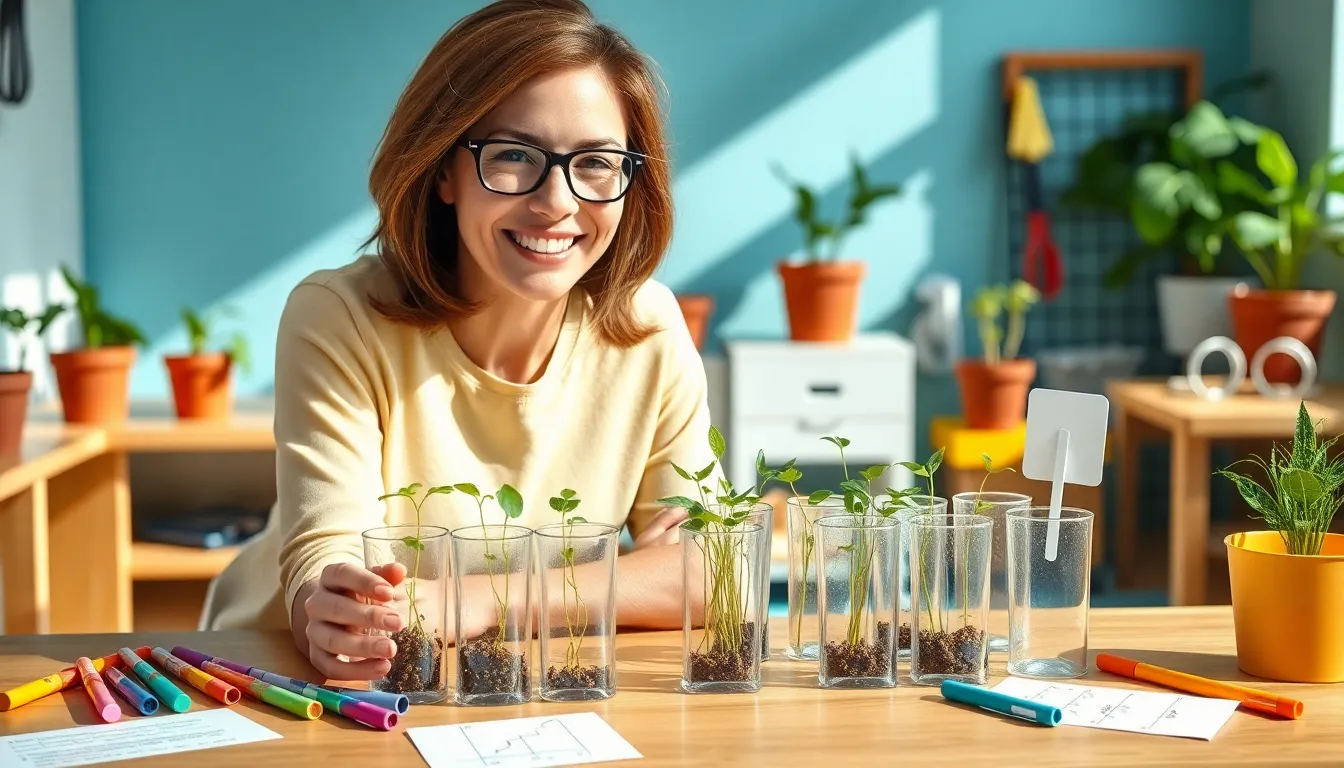
Transforming your garden laboratory into a hands-on science station opens up endless possibilities for discovery-based learning. We’ll explore three proven experimental approaches that make plant biology accessible and exciting for young learners.
Conduct Seed Germination Tests in Clear Containers
Clear containers become windows into the hidden industry of plant development when we use them for seed germination experiments. Plant seeds in transparent jars filled with soil or damp paper towels to create observation stations where children can watch roots sprout and shoots emerge. The transparency allows preschoolers to witness the complete germination process that normally happens underground, making abstract concepts concrete and visible.
Mason jars, clear plastic cups, and glass containers work perfectly for these experiments. Position seeds against the container walls so children can easily observe the development stages. Document the daily changes with simple drawings or photos to reinforce the learning experience and help children understand how plants develop over time.
Explore What Plants Need to Grow Through Variables
Variables create the perfect learning opportunities when we systematically change growing conditions to observe different outcomes. Place identical seeds in different environments to test how light, water, soil types, and temperature affect plant growth. Some containers can sit in sunny windowsills while others remain in dark closets to demonstrate light requirements.
Water becomes another variable when we provide regular watering to some plants while withholding it from others. Temperature variations work well by placing containers in warm areas versus cool spaces. Children observe and document these differences, developing inquiry skills while discovering what plants truly need to thrive.
Different soil types, including potting mix, sand, and clay, offer additional experimental possibilities. Watch how seeds respond to various growing mediums and discuss the results with your young scientists.
Test Different Growing Conditions and Document Results
Controlled environments like egg carton greenhouses provide perfect testing grounds for comparing different growing conditions. Create multiple setups using various containers to see how environmental factors impact seed sprouting and plant development. Children participate by watering plants, making daily observations, and maintaining simple records of their discoveries.
Growth documentation becomes an captivating science activity when children draw pictures or use growth charts to track plant progress. Measuring tools help preschoolers record height changes and compare plants grown under different conditions. Simple recording sheets with pictures and symbols make it easy for young children to document their observations independently.
Temperature monitoring, moisture levels, and light exposure all become measurable variables that children can track and understand. These documented results create meaningful conversations about plant needs and scientific observation skills.
Develop Fine Motor Skills Through Garden-Themed Crafts
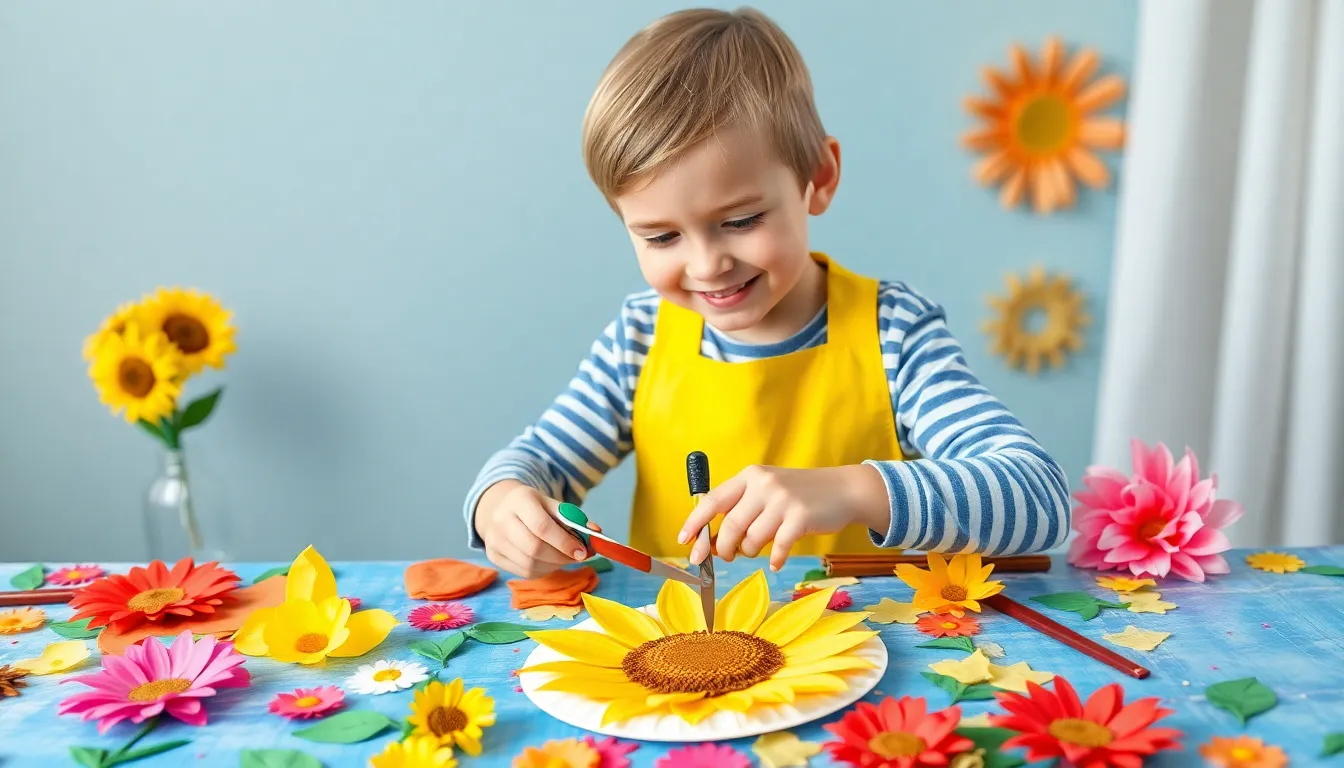
Garden crafts offer an captivating pathway for preschoolers to strengthen their hand muscles while exploring nature themes. We’ll discover how these creative activities build essential dexterity skills that support future writing and drawing abilities.
Make Paper Plate Sunflowers and Tissue Paper Flowers
Creating paper plate sunflowers strengthens hand muscles as children cut yellow construction paper petals and arrange them around the plate’s edge. Preschoolers develop precision with scissors while cutting petal shapes, building the finger strength needed for writing tasks. Glue application becomes a focused exercise in hand control as little ones carefully squeeze bottles and spread adhesive with brushes.
Tissue paper flowers require children to twist and scrunch delicate materials, improving finger dexterity through repetitive motions. We observe how preschoolers naturally improve their pincer grasp while manipulating tissue paper layers. The twisting motion needed to secure flower centers particularly benefits wrist flexibility and rotational control.
Both activities encourage bilateral coordination as children hold materials steady with one hand while working with the other. Fine motor precision develops through the careful placement of petals and the controlled pressure needed for effective gluing.
Create Seed Collages and Leaf Rubbings
Seed collages engage preschoolers in sorting activities that strengthen finger muscles through repeated grasping and releasing motions. Children practice controlled movements as they pick up individual seeds and place them precisely on paper surfaces. The sorting process by size or color enhances finger dexterity while building organizational skills simultaneously.
Gluing seeds requires measured pressure application and steady hand control, directly supporting pre-writing muscle development. We notice how children naturally adjust their grip strength when handling different seed sizes, from large sunflower seeds to tiny poppy seeds.
Leaf rubbings develop wrist control through the back-and-forth crayon motions needed to reveal leaf patterns. Preschoolers learn pressure application techniques as they discover how light strokes create detailed impressions while heavy pressure tears paper. This activity particularly enhances sensory awareness as children feel texture differences through their movements.
Hand positioning during leaf rubbings mirrors proper writing posture, making this create an excellent pre-writing exercise disguised as nature exploration.
Design Plant Pots Using Recycled Materials
Decorating recycled containers transforms everyday materials into personalized planters while building tool-handling skills. Children develop refined motor control as they wrap yarn around containers, apply stickers with precision, or paint decorative patterns. The circular motions used in pot decoration strengthen the same muscle groups needed for letter formation.
Assembling popsicle stick planters requires careful alignment and steady pressure during gluing, improving bilateral coordination skills. Preschoolers practice sequential steps as they position sticks, apply adhesive, and hold pieces together until secure. These construction activities build patience and focus alongside physical dexterity.
Using small tools like paintbrushes, foam brushes, and glue sticks during pot decoration refines the tripod grasp essential for pencil control. We encourage preschoolers to experiment with different applicators, building versatility in their hand movements and tool manipulation abilities.
Problem solving emerges naturally as children determine how to attach handles, create drainage holes, or balance decorative elements, combining cognitive development with motor skill enhancement.
Plan Outdoor Garden Adventures and Nature Walks

Expanding beyond our classroom garden laboratory, we’ll take preschoolers on exciting outdoor explorations that connect hands-on learning with real-industry botanical discoveries. These adventures transform our schoolyard into a living classroom where children observe plant life cycles, seasonal changes, and garden habitat diversity.
Identify Different Plants and Trees in the Schoolyard
Teaching preschoolers to recognize and name various plants in their schoolyard environment builds essential vocabulary development and botanical awareness. We’ll provide simple picture cards and matching worksheets that help children connect plant names with their physical features. Children learn about plant parts including roots, stems, leaves, and flowers while understanding each component’s exact role in plant survival.
Using child-friendly identification tools makes plant recognition an captivating game rather than a memorization task. We can create plant scavenger hunts where children search for exact trees, flowers, or leaf shapes throughout the outdoor space. These activities encourage careful observation as preschoolers compare leaf textures, bark patterns, and flower colors.
Structured identification lessons support science learning by introducing botanical concepts at an age-appropriate level. Children develop classification skills as they group plants by size, color, or leaf shape. We’ll establish regular “plant detective” walks where students use magnifying glasses to examine tree bark, leaf veins, and flower petals up close.
Collect Leaves, Seeds, and Natural Materials
Collecting natural materials during garden walks promotes sensory exploration and classification skills that enhance fine motor development. We’ll encourage children to gather leaves, seeds, pinecones, and flowers that can later be used for art projects, sorting activities, or seed planting experiments. This tactile involvement deepens understanding of plant reproduction and diversity while developing hand-eye coordination.
Storage containers and collection bags allow children to organize their nature treasures systematically. We can introduce simple sorting rules such as grouping items by color, size, or texture. Children practice counting and measuring skills as they compare seed sizes or count the number of different leaf shapes in their collections.
Seasonal collecting activities highlight changes in plant life throughout the year. Fall brings colorful leaves and various seed types, while spring offers fresh green growth and early flowers. We’ll create nature journals where children document their finds with drawings and simple descriptions, reinforcing observation skills and early writing practice.
Observe Insects and Animals in Garden Habitats
Preschoolers benefit tremendously from observing insects such as bees, butterflies, and ladybugs, which enhances their awareness of ecosystems and pollination processes. Guided observation activities support science concepts including habitat relationships, food chains, and peaceful coexistence between plants and animals. We’ll use bug viewers and magnifying glasses to examine insects safely without disturbing their natural behaviors.
Creating simple insect homes or bird feeders attracts garden wildlife and provides ongoing observation opportunities. Children learn responsibility through maintaining these wildlife stations while developing patience as they wait quietly for animal visitors. We can establish observation logs where students record the types of insects and animals they encounter during different times of day.
Building understanding of garden ecosystems helps children appreciate the interconnected relationships between plants, insects, and other animals. We’ll discuss how bees help flowers reproduce through pollination and how earthworms improve soil quality for plant growth. These conversations introduce complex scientific concepts through concrete, observable examples that preschoolers can understand and remember.
Integrate Math Concepts Using Plants and Garden Tools

Garden-based math activities transform abstract numerical concepts into tangible learning experiences for preschoolers. Our hands-on approach connects mathematical thinking with nature exploration through simple yet effective counting, measuring, and sorting activities.
Count Seeds, Leaves, and Flower Petals
Develop one-to-one correspondence through seed counting activities that make numbers meaningful for young learners. We encourage children to count individual seeds before planting, touching each one as they say the corresponding number aloud. This tactile approach reinforces number recognition while building foundational math skills.
Practice counting skills by examining leaves on classroom plants or flowers in our garden center. Children can count petals on daffodils, leaves on bean plants, or segments on orange slices during snack time. These natural counting opportunities occur throughout our daily garden activities.
Build number vocabulary as preschoolers announce their findings to classmates. We prompt children to use phrases like “I found five petals” or “This plant has seven leaves” during their observations. Recording these discoveries on growth charts creates additional counting practice while documenting plant development.
Measure Plant Growth and Compare Heights
Track plant development using child-friendly measuring tools like paper clips, blocks, or colorful rulers designed for small hands. We teach preschoolers to place measuring units end-to-end beside their growing plants, counting the total units to determine height. This non-standard measurement approach makes the concept accessible to young learners.
Compare plant heights through direct observation and measurement language activities. Children learn descriptive words like “taller,” “shorter,” and “same height” while examining their bean sprouts or sunflower seedlings. We encourage side-by-side comparisons that make mathematical relationships visible.
Document growth patterns in individual plant journals where children record weekly measurements. These growth charts become personalized math tools that reinforce measurement concepts over time. Preschoolers develop observation skills while practicing early data collection through their documented findings.
Sort Seeds by Size, Color, and Shape
Group seeds by physical attributes to introduce classification concepts that support mathematical reasoning. We provide mixed collections of beans, sunflower seeds, and pumpkin seeds for children to examine and organize. This hands-on sorting develops critical thinking skills while teaching category identification.
Practice attribute recognition through guided sorting activities using descriptive language. Children verbalize their sorting decisions by explaining “These seeds are round” or “This group contains only brown seeds.” We support their classification choices while expanding mathematical vocabulary.
Create seed patterns after initial sorting activities to extend mathematical learning. Preschoolers arrange sorted seeds into AB patterns like big-small-big-small or color sequences using their classified groups. These pattern activities connect sorting skills to early algebra concepts through concrete manipulatives.
Build Language Skills With Plant-Themed Books and Songs
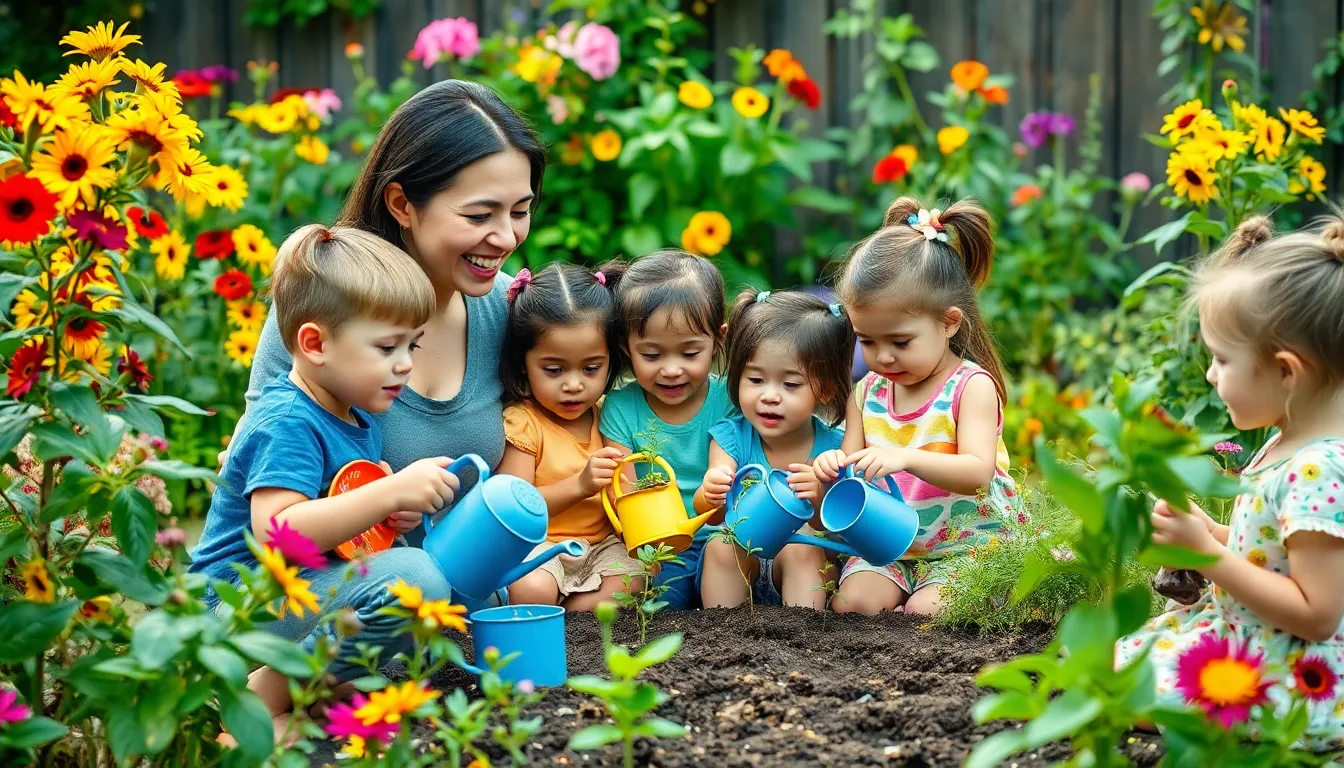
Building on our established garden laboratory experiences, we can now focus on developing preschoolers’ communication abilities through literature and music. Plant-themed books and songs create powerful language learning opportunities that complement our hands-on gardening activities.
Read Stories About Gardens and Growing Plants
Garden-themed books like My Garden by Kevin Henkes spark imagination while introducing essential vocabulary concepts. We can engage children by encouraging them to imagine magical gardens during storytime, which nurtures both creativity and language development. Reading these stories builds listening comprehension skills as preschoolers encounter new words related to planting, growing, and garden life.
Storytime discussions become particularly valuable when we ask open-ended questions about the books. Children practice using newly learned vocabulary in conversation, reinforcing their understanding of garden concepts. We should encourage preschoolers to describe what they see in illustrations, predict what might happen next in the story, and connect the book’s content to their own gardening experiences.
Interactive reading sessions work best when we relate story elements to our classroom garden activities. Children can identify plants from books in their own garden observations, creating meaningful connections between literature and real-industry experiences. This approach strengthens both comprehension skills and botanical knowledge simultaneously.
Sing Songs About Seeds, Flowers, and Trees
Garden-themed songs help preschoolers internalize plant-related vocabulary through rhythm and repetition. We can use simple lyrics about planting seeds, watching flowers grow, and describing different types of trees to build language skills naturally. Singing fosters phonemic awareness while expanding vocabulary in an enjoyable, memorable way.
Repetitive songs work particularly well for young learners, as they can predict upcoming words and phrases. We should incorporate movement and gestures that represent planting, growing, and blooming actions during song time. These physical movements help children remember new vocabulary while captivating multiple learning pathways.
Creating our own simple garden chants allows us to customize vocabulary to match our current planting activities. Children can contribute ideas for lyrics, practicing creative expression while reinforcing recently learned plant terminology. Musical patterns help embed new words in long-term memory more effectively than traditional vocabulary instruction alone.
Expand Vocabulary With Garden-Related Words
Garden themes enable preschoolers to learn both descriptive and scientific terms related to plant life. We can introduce essential vocabulary including seed, soil, roots, stem, leaf, flower, pollination, and growth through interactive activities and concrete experiences. These words become meaningful when children can connect them to actual plants they’re observing and tending.
Interactive games like garden alphabet activities, flower syllable exercises, and plant parts puzzles introduce and reinforce vocabulary in captivating contexts. We should create garden-themed word walls with pictures and labels that children can reference during activities. These visual supports help preschoolers connect written words with concrete objects and concepts.
Sensory experiences strengthen vocabulary acquisition by tying new words to memorable encounters. When children plant seeds, touch different leaf textures, or smell various flowers, they create strong mental connections to associated vocabulary. We can narrate these hands-on experiences using rich descriptive language, helping children build comprehensive understanding of garden terminology through multiple senses.
Encourage Healthy Eating Through Garden-to-Table Activities
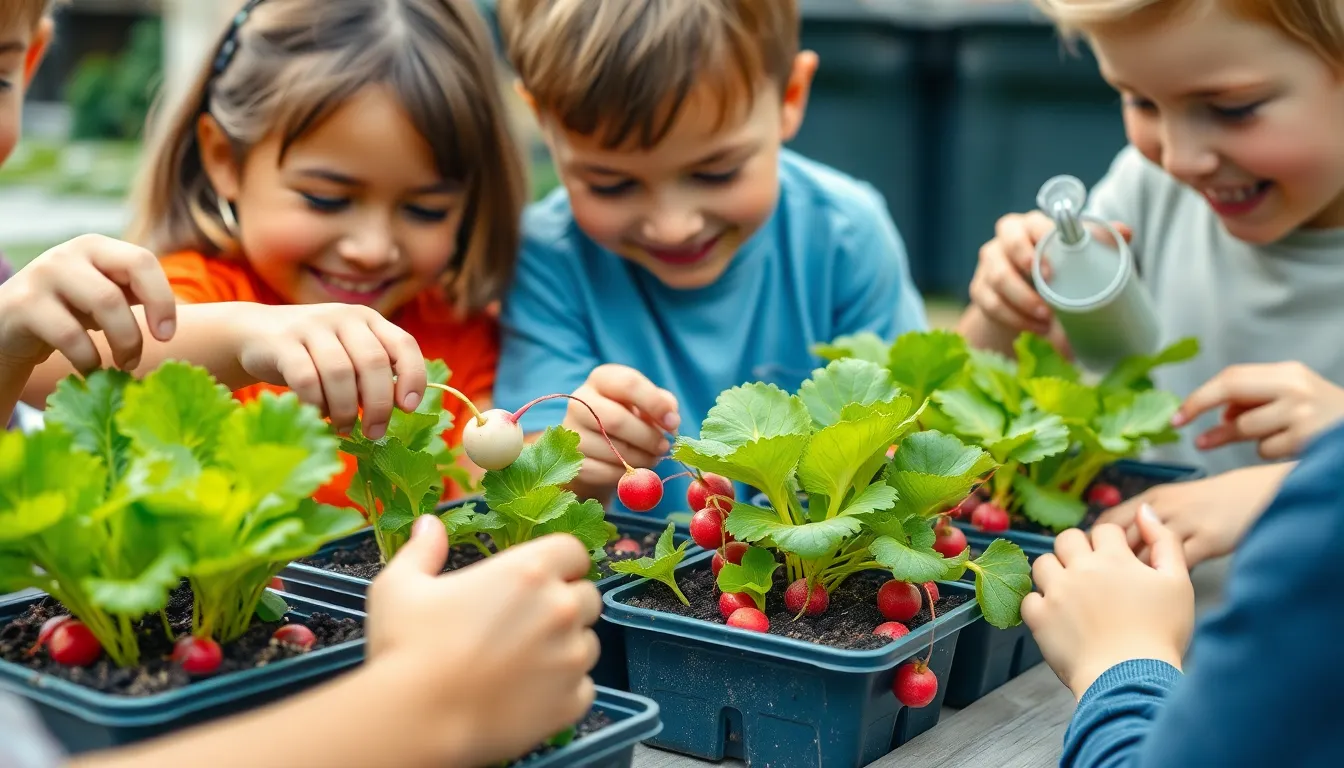
Building on our established garden laboratory, we can now transform our preschoolers’ gardening experiences into powerful tools for developing healthy eating habits. Garden-to-table activities create meaningful connections between children and their food while increasing their willingness to try nutritious fruits and vegetables.
Grow Simple Vegetables Like Lettuce and Radishes
Lettuce provides the perfect starting point for our preschool garden because it matures quickly and requires minimal care from young gardeners. Children can see results within 3-4 weeks, keeping their interest high throughout the growing process. We can harvest lettuce leaves multiple times from the same plant, giving preschoolers repeated opportunities to connect their gardening efforts with fresh food.
Radishes work exceptionally well in preschool settings because they germinate in just 3-5 days and reach maturity in 25-30 days. Children love pulling these bright red vegetables from the soil, making the harvest experience exciting and rewarding. Both vegetables grow easily in containers or small garden beds, perfect for classroom spaces or limited outdoor areas.
Fast-growing vegetables keep preschoolers motivated because they can observe daily changes in their plants. We can involve children in simple care tasks like watering and checking for growth, building their sense of responsibility and ownership. These quick-maturing crops provide multiple learning opportunities throughout the school year without requiring long-term patience from young learners.
Prepare Healthy Snacks From Garden Produce
Fresh lettuce from our classroom garden transforms into exciting snack preparations that children eagerly participate in creating. We can guide preschoolers through washing their harvested lettuce leaves, teaching proper food safety while building independence. Tearing lettuce into bite-sized pieces develops fine motor skills and gives children ownership over their food preparation.
Simple salads become adventures when children combine their homegrown lettuce with other nutritious ingredients. We can create veggie wraps using tortillas filled with fresh lettuce, giving children hands-on experience with healthy meal assembly. Adding nutritious dips like hummus or ranch enhances flavors and encourages vegetable consumption over less healthy alternatives.
Radishes offer opportunities for creative snacking that surprises children with new flavors and textures. We can slice radishes for tasting experiences, helping preschoolers develop adventurous eating habits. Serving fresh vegetables with familiar, healthy accompaniments makes trying new foods less intimidating and more enjoyable for young eaters.
Discuss Where Food Comes From and Nutrition
Garden-based learning provides natural opportunities to teach preschoolers about food origins through direct observation and experience. Children understand plant growth cycles more clearly when they’ve planted seeds and watched them develop into edible vegetables. We can discuss how plants need sunlight, water, and nutrients to grow healthy and strong, just like children need good food to grow.
Nutrition education becomes concrete when children can touch, smell, and taste the vegetables they’ve grown themselves. We can introduce concepts from MyPlate through resources like “Grow It, Try It, Like It!” nutrition education kits that make balanced eating captivating for young learners. These discussions help children understand why fruits and vegetables are important for their health and energy.
Plant growth observations create perfect teaching moments about the journey from seed to table. Children develop foundational knowledge about healthy eating when they see firsthand how their food grows. We can connect these experiences to broader nutrition concepts, helping preschoolers understand that fresh vegetables provide vitamins and minerals their bodies need to stay healthy and strong.
Foster Responsibility With Plant Care Routines
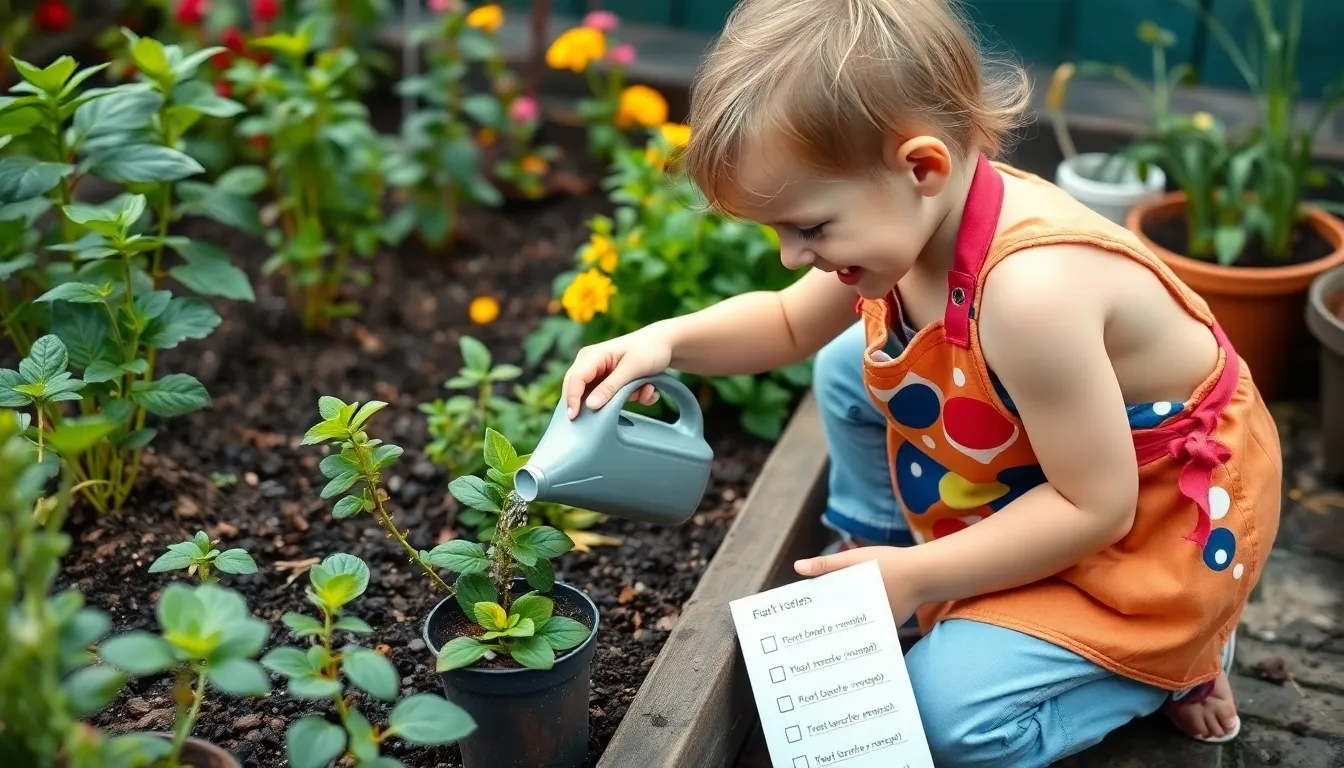
Teaching preschoolers to care for plants creates meaningful opportunities to develop responsibility and accountability. We’ve found that structured plant care routines help children understand the needs of living things while building essential life skills.
Assign Daily Watering and Care Tasks
Daily watering assignments give preschoolers concrete responsibilities that they can understand and accomplish independently. We recommend starting with simple tasks like checking soil moisture by touching the surface or using small watering containers that children can handle safely. Rotating responsibilities among different children ensures everyone gets experience with various aspects of plant care including watering, observing growth changes, and removing dead leaves.
Morning care routines work particularly well because children arrive fresh and eager to check on their plants. Tasks should remain age appropriate, such as using spray bottles for misting plants or small watering cans for larger containers. We’ve observed that preschoolers take great pride in being assigned exact plants to care for, creating a sense of ownership and dedication to their green companions.
Create Plant Care Schedules and Checklists
Visual schedules transform abstract care concepts into concrete steps that preschoolers can follow independently. We suggest creating picture based checklists showing watering cans, sunshine symbols, and plant images that children can mark off as they complete each task. These organizational tools support memory development and sequencing skills while reinforcing accountability for plant wellbeing.
Color coded systems work exceptionally well for different types of plants or care schedules. Simple charts with spaces for children to place stickers or checkmarks provide immediate satisfaction and visual progress tracking. We recommend positioning these schedules at child eye level near the garden center so young learners can reference them easily throughout their care routines.
Teach Gentle Handling of Living Things
Gentle handling instruction instills respect for living organisms while supporting fine motor development in preschoolers. We demonstrate proper techniques for touching leaves without pulling or tearing, showing children how to support stems when examining plants closely. Role modeling becomes crucial as we guide small hands around delicate seedlings and teach mindful movement near growing plants.
Practice sessions with different plant materials help children understand varying levels of fragility. Sturdy plants like succulents provide excellent starting points for hands on exploration, while more delicate seedlings teach careful observation without touching. We emphasize using “gentle fingers” and “soft touches” as verbal cues that children can remember and apply independently during their plant interactions.
Conclusion
We’ve explored how plants and gardening create powerful learning opportunities that extend far beyond traditional classroom activities. This comprehensive approach transforms young minds into curious scientists while building essential skills through hands-on exploration.
The beauty of garden-based learning lies in its ability to connect multiple developmental areas simultaneously. From strengthening fine motor skills through seed planting to developing mathematical concepts through growth measurements children engage with learning in meaningful ways.
Most importantly we’ve seen how this theme nurtures responsibility and environmental awareness in our youngest learners. When preschoolers care for living plants they develop empathy and understanding that extends to their relationship with the natural industry.
By implementing these garden-focused activities we’re not just teaching about plants—we’re cultivating lifelong learners who appreciate nature’s wonders and understand their role as caretakers of our environment.
Frequently Asked Questions
Why is teaching preschoolers about plants and gardening beneficial?
Teaching preschoolers about plants and gardening creates magical learning moments that combine sensory experiences with essential educational concepts. Children develop fine motor skills, enhance observation abilities, and learn about responsibility and life cycles through hands-on activities. This approach makes abstract botanical concepts concrete and engaging for young learners.
How can I set up a garden laboratory in my classroom?
Create a dedicated garden center with child-sized tools like small trowels and watering containers. Display seed packets and garden catalogs at eye level, include magnifying glasses for seed examination, and add measuring tools for tracking plant growth. Organize planting stations to encourage independent exploration and hands-on learning.
What are some effective plant growth experiments for preschoolers?
Use clear jar methods and “sprout houses” with bean seeds to observe growth. Conduct seed germination tests in transparent containers and explore variables by changing light, water, soil types, and temperature conditions. Create controlled environments using egg carton greenhouses to compare different growing conditions.
How do garden-themed crafts help develop fine motor skills?
Activities like making paper plate sunflowers and tissue paper flowers strengthen hand muscles and improve dexterity. Seed collages and leaf rubbings enhance finger dexterity and wrist control. Creating plant pots from recycled materials helps children refine tool-handling skills while encouraging precision and control.
What outdoor activities can enhance plant learning?
Plan garden walks and nature adventures to observe plant life cycles and seasonal changes. Use plant scavenger hunts and identification lessons with picture cards to build vocabulary. Collect natural materials for art projects and maintain nature journals to document findings and seasonal plant changes.
How can gardening activities support math learning?
Use hands-on counting with seeds, leaves, and flower petals to develop one-to-one correspondence. Measure plant growth with child-friendly tools and compare heights. Sort seeds by size, color, and shape to introduce classification concepts. These activities make abstract mathematical concepts tangible and enjoyable.
What role do books and songs play in plant education?
Plant-themed literature like “My Garden” by Kevin Henkes introduces essential vocabulary and sparks imagination. Interactive reading sessions with open-ended questions enhance comprehension. Garden-themed songs help children internalize plant-related vocabulary through rhythm and repetition, fostering phonemic awareness and language development.
How can garden-to-table activities promote healthy eating?
Grow quick-maturing vegetables like lettuce and radishes to keep children engaged. Prepare healthy snacks from garden produce, allowing children to participate in food preparation. This hands-on approach helps preschoolers understand food origins, develop nutrition awareness, and connect gardening with healthy eating habits.
What daily care routines help children learn responsibility?
Assign structured watering and plant care tasks using visual schedules and checklists. Teach gentle handling techniques to instill respect for living organisms. These routines help children develop accountability and independence while supporting fine motor development through regular plant care activities.

